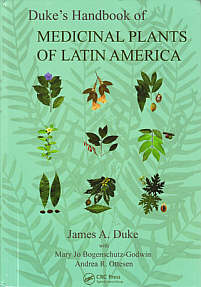Simarouba here refers to both "Simarouba amara" and "Simarouba glauca" as both have
the same properties. Also known as
, Simarouba refers to
a flowering tree that grows 40 to 50 feet in height and spans 25 to 30 feet.
The flowers are usually yellow and the fruit elongated and purple.
Uses & Protocols

Europeans found indigenous groups in South America
using Simarouba to effectively treat dysentery and malaria in the early 1700's, centuries
before the rise of the pharmaceutical industry. It is also used to treat fevers, diarrhea,
intestinal worms, anemia, and indigestion. Owning to its strong anti-viral properties,
Simarouba has been shown in multiple studies to be effective
in vitro against
herpes, influenza, polio, and vaccinia viruses. (The field is still in need of well-constructed
anti-viral studies,
in vivo.)

Taylor reports that the National Cancer Institute performed
early cancer screenings in 1976, showing that Simarouba was toxic against cancer cells at
very low dosages. What followed were further studies showing this plant's antileukemic action.

Lastly, Simarouba is being used for topical applications
for skin depigmentation (i.e. liver spots) and keratinocyte differentiation (protecting against
scaly skin.)

Dosage: one capsule, two times a day.
Warnings & Contraindications

None reported where taken at normal, therapeutic dosages.
In higher than recommended dosages, nausea and vomiting may result. There are no reported
drug contraindications.
Shelf-Life

Five years or more.

Medicinal Activities
 Further information for practitioners:
Further information for practitioners:
World-famous botanist Dr. James Duke attributes the following activities
to this plant
(p. 638-639; see hardcopy cover at right),
drawn from the extant literature. (See his graduation for "level of
efficacy" on our
amazon traditionals page;
followed by Duke's bibliographic abbreviations (in capital letters),
which we
identify
on a separate page.)

Duke provides a "
food farmacy potential" score for this
plant of "FNFF=!."
- Amebicide (f1; MAX; RAI; TRA)
- Analgesic (f1; AHL; AUS; RAI)
- Anticancer (1; X15852485)
- Antileukemic (f; AUS)
- Antimalarial (f1; IED; JFM; X9210673)
- AntiMDR (1; RAI)
- Antiseptic (1; AUS; RAI)
- Antitumor (1; RAI)
- Antiviral (1; RAI)
- Astringent (1; AAB)
- Bactericide (1; AUS; RAI; X2214824)
- Bronchoconstrictor (1; TRA)\
- Choleretic (f; DLZ)
- Cytotoxic (1; X15852485; X9210673)
- Diaphoretic (1; RAI)
- Diuretic (f; RAI)
- Emetic (f; AUS)
- Febrifuge (f1; MAX; RAI)
- Hemostat (1; RAI)
- Insecticide (1; TRA)
- Locusticide (1; TRA)
- Parasiticide (1; RAI)
- Pediculicide (1; TRA)
- Purgative (f; AUS)
- Stomachic (f; AUS; JFM; MAX)
- Sudorific (f; AHL, AUS)
- Tonic (1; RAI; TRA)
- Vermifuge (f1; AUS; RAI)
Indications
 Further information for practitioners:
Further information for practitioners:
Duke provides the following indications for this plant:
- Amenorrhea (f1; AHL; RAI)
- Anemia (f; AHL; RAI)
- Bacteria (1; AUS; RAI; X2214824)
- Biliousness (f; DLZ)
- Bleeding (f1; AUS; RAI)
- Cancer (1; X15852485)
- Colic (f; AHL; RAI)
- Colitis (f1; RAI)
- Dermatosis (f; TRA)
- Diarrhea (f1; AAB; AHL; JFM: RAI)
- Dysentery (f1; AAB; AHL; RAI)
- Dysmenorrhea (f; AUS; RAI)
- Dyspepsia (f; AHL; MAX; RAI)
- Enterosis (f; RAI)
- Fever (f1; JFM; MAX; RAI)
- Gastrosis (f1; AUS; RAI; TRA)
- Gonorrhea (f; AHL)
- Hemorrhage (1; AAB)
- Hepatosis (f; DLZ)
- Herpes (1; RAI)
- Infection (1; AUS; RAI; X2214824)
- Itch (f; TRA)
- Leukemia (f1; AUS; RAI)
- Liver Spots (f; RAI)
- Malaria (fl; IED; JFM; RAI; TRA; X9210673)
- MDR (l; RAI)
- Metrorrhagia (l; AAB)
- Pain (fl; AHL; AUS; RAI)
- Parasites (l; RAI)
- Pediculosis (fl; TRA)
- Polio (l; RAI)
- Rashes (f; TRA)
- Rheumatism (f; AHL)
- Salmonella (1; RAI; TRA)
- Sarcptosis (1' TRA)
- Scabies (l; TRA)
- Shigella (l; RAI; TRA)
- Sores (fl; AAB; AUS; RAI)
- Tumors (l; RAI)
- Ulcers (l; TRA)
- Vaccinia (l; RAI)
- VD (f; AHL; RAI)
- Viruses (1; RAI)
- West Nile (f; RAI)
- Whitener (1; RAI)
- Worms (f1; AUS; RAI)
- Wounds (f; RAI)





